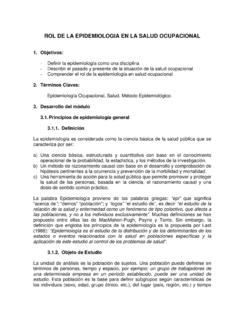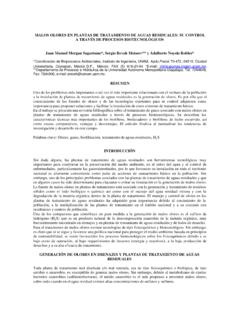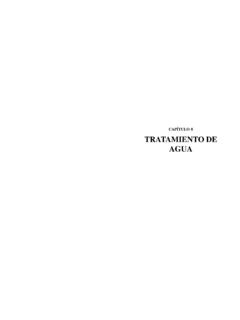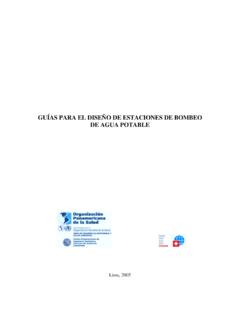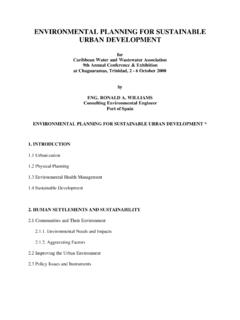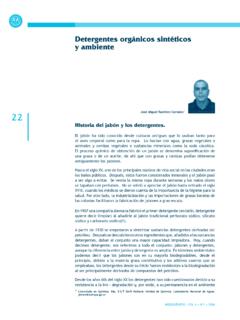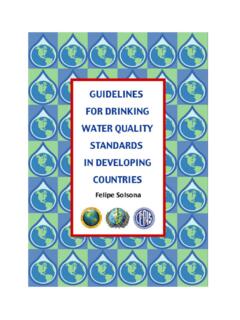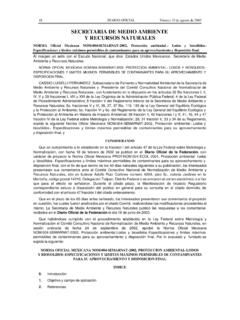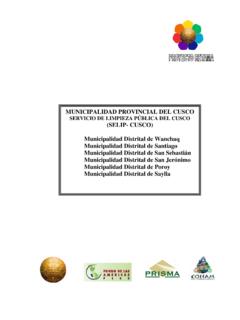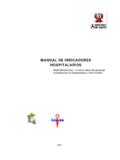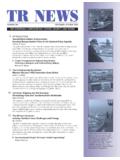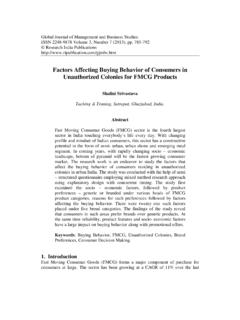Transcription of THE GLOBAL MARKET FOR SOAPS
1 THE GLOBAL MARKET FOR SOAPS A MARKET research Report For the Public-Private Partnership on Handwashing with Soap THE LONDON SCHOOL OF HYGIENE & TROPICAL MEDICINE 2 The GLOBAL MARKET for SOAPS CONTENTS Acknowledgements Acronyms List of Figures and Tables Executive Summary Chapter 1: Introduction A Public-Private Partnership Mutual benefits research objective Methods and sources of information What is soap? Soap - a brief history The MARKET for SOAPS Chapter 2: The MARKET The world MARKET for soap Markets in the developed world The soap MARKET in developing countries Latin America Asia Africa and the Middle East Central and Eastern Europe Chapter 3: Soap production and promotion in the GLOBAL MARKET Nature of the GLOBAL industry Promotion and branding Corporate focus: SOAPS and detergents Growth and expansion strategies MARKET segmentation Mergers and acquisitions How local companies are responding to multinational strategies Chapter 4: The PPP Hand Wash Initiative Motivation to participate in the PPP Threats Appendix 1: Population Statistics Appendix 2: Emerging markets and their key players i) Latin America ii) Asia iii) Africa and the Middle East iv) Central and Eastern Europe Appendix 3: Corporate profiles Appendix 4.
2 List of relevant web-sites Appendix 5: References 3 Figures and Tables Figure 1 The Public Private Partnership: health and well-being promotion routes Figure 2 GLOBAL soap consumption: regional distribution (2000) Figure 3 Developing World Income Pyramid (Annual Income at 1998-2000) Figure 4 P&G turnover by product category 1999 Figure 5 Unilever sales by product category 1999 Table 1 Formulations and uses of SOAPS and non-soapy detergents Table 2 Fats and oils in main commercial use for soap-making Table 3 The top 20 GLOBAL players in the SOAPS and detergents industry Table 4 Advertising spend in 2000 Table 5 Key players: brand ownership in top 50 brands Table 6 Regional Trends in Population Growth 1995 1999 Table 7 Major markets: trends in population growth 1995-1999 Table 8 Emerging markets: trends in population growth 1995 1999 Table 9 GLOBAL soap sales by region Table 10 Bath and shower products - value sales by emerging markets 1995-1999 in Latin America Table 11 Value sales of bath and shower products by country indexed growth (1995-1999) in Latin America Table 12 Value sale of bath and shower products per capita by country (Latin America)
3 Table 13 The MARKET share of major players in North and South America Table 14 The MARKET share of major players in Asia-Pacific and South Asia Table 15 The MARKET share of major players in Middle East and Africa Table 16 The MARKET share of major players in Western and Eastern Europe 4 Acronyms EHP Environmental Health Group FMCG Fast moving consumer goods LSHTM London School of Hygiene &Tropical Medicine NGO Non-governmental organization NSD Non soapy detergents PPP Public-Private Partnership WB World Bank WSP Water and Sanitation Program 5 Executive summary Though diarrhoea kills over 2 million children a year, it is increasingly neglected by international and national health programmes. The simple act of washing hands with soap could save almost half of these lives. However, handwashing with soap at critical times is practiced by less than 20% of the population of developing countries.
4 Poor handwashing is also a major concern in industrialised countries. Whilst public investment in handwashing could produce major health benefits, private industry is also prepared to invest in soap promotion, because they wish to grow the MARKET for SOAPS . This report presents a brief overview of the GLOBAL MARKET for soap to provide context for a new public-private partnership on handwashing. Led by the Water and Sanitation Programme (WSP) with the World Bank s and the London School of Hygiene and Tropical Medicine (LSHTM) the initiative sets out to demonstrate the feasibility and value of such approaches in Ghana and India to show the way for wider replication. Key findings of this survey include: The soap MARKET is divided into true SOAPS (a combination of fat and a caustic material) and non-soapy detergents (largely petroleum by-products). SOAPS and NSDs can be formulated into bars, flakes, powders and liquids.
5 All can be used for handwashing. Soap is marketed for body washing and laundry and not for handwashing in poorer countries. The strong growth in the handwash liquids MARKET in developed economies demonstrates that there is a MARKET opportunity for appropriate products. Handwashing promotion will grow the MARKET for SOAPS both by increasing consumption and by introducing new customers. The poorer sections of society are the poorest served by the MARKET but the fastest growing in terms of numbers. Purchasing power in the poorer segments is not increasing as rapidly as unsatisfied demand, highlighting the need to find cheaper products. The world MARKET for SOAPS and NSDs was worth US$ 88 billion in 2000, having grown by 29% since 1996. The MARKET for soap products is largely mature in developed markets and displays stagnant growth. The growth potential in developing countries is huge, but there are many obstacles to expansion.
6 Recent growth in the mature developed world MARKET reflects the heavy promotion of new product formulations, notably liquid hand SOAPS with or without antibacterials. The future is likely to see trends towards natural products, and those with added value, further efforts at brand extension by the big players and further price competition leading to growth in the share of supermarket own label products. 6 In developing and emerging markets the drivers of growth have been aspiration and growing populations. Increasing disparity of income, and increased consumption by the elites drives aspiration in the poorer segments. So does hugely expanded access to TV and communications. Cheaper products will be needed to satisfy these aspirations in poorer segments. However, moving into cheaper product ranges can dent profitability. Other factors likely to encourage soap marketing and consumption in developing countries in the future include: More discriminating educated and aware consumers.
7 Growth of the media, especially TV Improvements in transportation and communication networks. Innovative R&D for raw materials and finished products. Growth of supermarkets and retail outlets. High speed packaging machines and attractive packaging materials. State of the art technology to enhance productivity and reduce cost. Increasingly talented advertising and MARKET research agencies. Liberalisation of markets and growth in free trade. Soap multinationals spend hugely on advertising, for example Unilever is the world s number one company in terms of advertising expenditure. There has been a recent trend to group products under one name, eg Palmolive Botanicals to improve brand visibility and loyalty. It is generally more economical to produce soap locally than to import. Major manufacturers have thus sought to expand to neighbouring countries, to acquire, merge with or do a distribution deal with a local manufacturer.
8 Local manufacturers are fighting back by using their local knowledge and capacity for rapid innovation to expand into new niches in an unsaturated MARKET or by producing cheaper product ranges. Whilst local manufacturers can exploit specific opportunities, bigger companies are gaining ground overall through their economies of scale and heavy investment in knowledge. All of the multinational companies contacted wished to participate in the PPP. They believed that much could still be learnt about soap for handwashing and about poorer segments of society. They felt that contact with governments and external agencies could lead to levelling of fiscal playing fields and improvement in the environment for the promotion of hygiene. 7 CHAPTER 1: INTRODUCTION Diarrhoea kills over 2 million children a year. It is caused by ingesting the bacteria, viruses and protozoa that are found in human excreta.
9 Hands are a primary vector of transmission. They get contaminated during defecation or when cleaning a child that has defecated and carry microbes to food, fluids and new hosts (Curtis, 2000). However, much diarrhoea is preventable, by the simple act of washing the hands with soap after contact with faeces. Observations of handwashing in different developing country settings suggest that soap use after the toilet or after cleaning up a child is rare (average less than 15% of occasions), but is also low in developed countries. There is scientific evidence that this simple action could potentially save a million lives a year (Curtis & Cairncross, in preparation). Personal hygiene behaviour cannot be legislated, and merely providing water and sanitation facilities with or without hygiene education has not created sufficient motivation or compulsion for change in hygiene practices. Although the need for hand washing at critical times has long been recognized, efforts to promote this behaviour have been sporadic, uncoordinated and mostly ineffective.
10 A Public-Private Partnership The search for new and effective ways of addressing this need world-wide, and particularly in developing countries where diarrhoea is most prevalent, has brought together a coalition of international and national organizations. These bodies, including the Water and Sanitation Program (WSP), in collaboration with the World Bank (WB), the London School of Hygiene &Tropical Medicine (LSHTM), the Environmental Health Group (EHP), the Government of Ghana, Basic Support for Institutionalizing Child Survival (BASICS) the Government of the State of Kerala India, UNICEF and Private Sector agencies, are unfolding a GLOBAL initiative. The Public and Private sectors, together with non-governmental organizations (NGOs) will form a GLOBAL Public-Private Partnership (PPP) to combine commercial and social marketing capabilities, and resources to achieve an important public health objective, which is to save millions of lives around the world (especially those of children), from diarrhoeal diseases.
